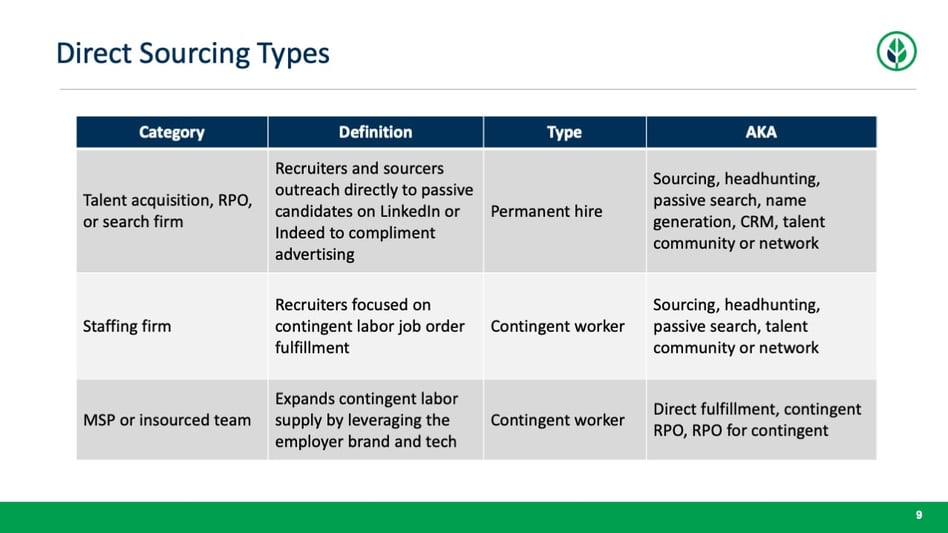
Direct sourcing has become increasingly referenced in contingent labor and is a component of a total talent acquisition strategy. Direct sourcing can provide organizations with unique advantages: cost savings, faster recruitment processes, and specific skill sets needed on a case-by-case basis – to name a few potential benefits. However, understanding exactly what direct sourcing is is critical if employers want to maximize its value.
RPOA Executive Director Lamees Abourahma recently hosted an RPO Leadership Forum webinar with trusted recruitment process adviser Jason Krumwiede, Executive Vice President of Broadleaf Results. Krumwiede discussed direct sourcing as it relates to contingent labor. He defined direct sourcing, presented the best practices for a successful program, and described why the future is bright for direct sourcing. Below is a recap of his presentation.
What is Direct Sourcing
Krumwiede defined direct sourcing as a value-add service of an MSP provider or organization's in-sourced team. Direct sourcing expands the contingent labor supply by proactively forecasting future contingent labor needs. It uses the organization's data and employment brand to source, attract candidates, and pre-qualify workers before hiring managers receive requisitions. Put another way, "Think of it as a talent community database. When candidates apply directly for a permanent or full-time job, they can also see what temp jobs are available without going through a staffing supplier," Krumwiee said.
He added that there's confusion around the term "direct sourcing," and this misunderstanding of the term can hinder adoption. Krumwiede clarified that direct sourcing fits within the total talent management spectrum. Total talent management (TTM) is a comprehensive approach to workforce management that allows organizations to make resourcing decisions based on specific tasks and align the right talent for their needs. The spectrum of services within TTM consists of the following:
-
Payroll Services
-
Managed Service Programs (MSP)
-
Direct Sourcing
-
Recruitment Process Outsourcing (RPO)
-
Technology Services (ATS, CRM, VMS)
-
Statement of Work(SOW) and Procurement Management
He shared that direct sourcing fits between MSP and RPO because RPO providers often have in-house direct sourcing capabilities and use those capabilities frequently.
Direct Sourcing De-Mystified
RPOs and MSPs use direct sourcing but in different ways. However, staffing firms do not use direct sourcing at all. To illustrate this point, Krumwiede shared that within direct sourcing, there are two direct sourcing types: permanent hires and contingent workers. He observed that the confusion around the term "direct sourcing" stems from how service category providers approach these direct sourcing types. RPOs and talent acquisition teams proactively focus on permanent hires. They directly reach out to passive candidates using external resume databases, such as Indeed and LinkedIn, that complement the organization's job advertising efforts. MSPs proactively focus on contingent labor. They use internal databases, technology, and the employer brand to expand the contingent labor supply. Recruiters at staffing firms also focus on contingent labor, but Krumwiede emphasized that they focus on contingent labor job fulfillment, which is reactive. The recruiters begin sourcing after they receive the requisition. To sum up, RPOs and MSPs use direct sourcing because they proactively target permanent hires and contingent labor, respectively. But staffing firms don't use direct sourcing because they fill contingent labor jobs reactively.

Benefits of Direct Sourcing
Krumwiede noted four key benefits to direct sourcing related to contingent labor. Those benefits are the following:
-
Cost savings: MSP can payroll referred candidates at a lower markup than staffing suppliers.
-
Cycle times: Accelerated recruitment process provides greater efficiencies and shortened cycle times.
-
Quality: Segmented and robust talent communities curated for specific locations, job functions, and job titles.
-
Experience: AI helps drive efficiency and engagement, and two-way text messaging provides instant communication.
Direct Sourcing in Action
To illustrate the effectiveness of direct sourcing, Krumwiede described how direct sourcing solved a retiree skills gap for an advanced manufacturer of aircraft, space and defense, industrial, and medical devices. The manufacturer had a significant spike in employees retiring because of the organization's early retirement offer. As a result, there was an extreme skills gap between retirees leaving the organization and new employees needing to be fully trained.
Broadleaf used direct sourcing from alumni pools/retirees for temporary placement, bridging the experience and productivity gap. It used HR data to segment the population, conduct outreach and assess retirees. From its segmentation, outreach, and assessment, it was able to streamline the selection and onboarding workflow.
The results of Broadleaf's direct sourcing efforts were the following:
-
290 skilled candidates sourced and interested
-
Payrolled 30+ productive contingent workers
-
Streamlined onboarding process bottlenecks
-
Reduced turnover, increased contractor productivity, and limited OT hours
Tips For Implementing Successful Direct Sourcing
Krumwiede said that a successful direct sourcing program needs the following six elements:
-
Run on a robust CRM platform: Technology and advanced processes are necessary for successful direct sourcing.
-
Engaged, opt-in talent community: Companies can establish an entry into the direct sourcing platform by providing an opt-in talent community and informing potential applicants of contingent job opportunities.
-
Segmentation: Segmenting the population helps to ensure relevant information is delivered to the intended target audience.
-
Curate: Recruiting organizations should find and gather potential candidates into a talent community and continually engage them to keep their interest in the organization.
-
Push relevant jobs via text to the community: Texting is a quick and effective way to engage with the talent community and promote relevant job opportunities.
-
Recruit!: Recruiting is a vital part of selecting interested candidates, and there are best practices to follow for MSP direct sourcing.
The Future of Direct Sourcing
Krumwiede is optimistic about direct sourcing. He believes its future is bright and will grow significantly. He shared that data capture, employment branding, and technology are vital contributors to the future growth in direct sourcing. Capturing critical data to build an opt-in community, such as cold applicants, retirees, and alumni, is essential for the future adoption of direct sourcing. Organizations are spending money to attract applicants and have them opt into their talent community, which allows HR to monetize the data and strengthen their employment brand. Technology platforms and AI allow for increased efficiency and automation of communication streams.
Despite challenges, the impact of successful direct sourcing for contingent labor should not be underestimated. By leveraging a direct sourcing approach to recruiting contingent labor, companies can tap into the advantages of direct sourcing and shore up any skill gaps. Technical infrastructure, advanced segmentation, opt-in talent community engagement, and robust recruitment processes must be in place to ensure it runs smoothly. Ultimately, data capture processes will further power the growth of successful direct sourcing and enhance visibility into contingent labor trends. Head to the RPO Academy to watch this informative and enlightening webinar to learn more about the advantages of direct sourcing for contingent labor – we guarantee you won't regret it!














